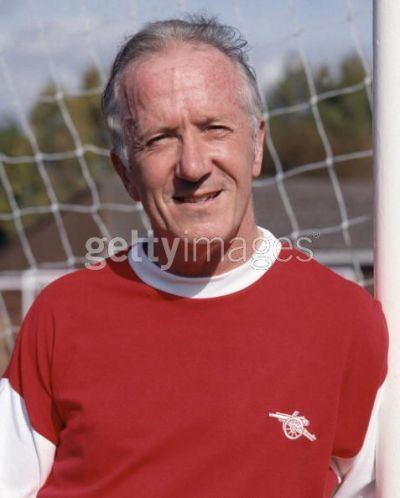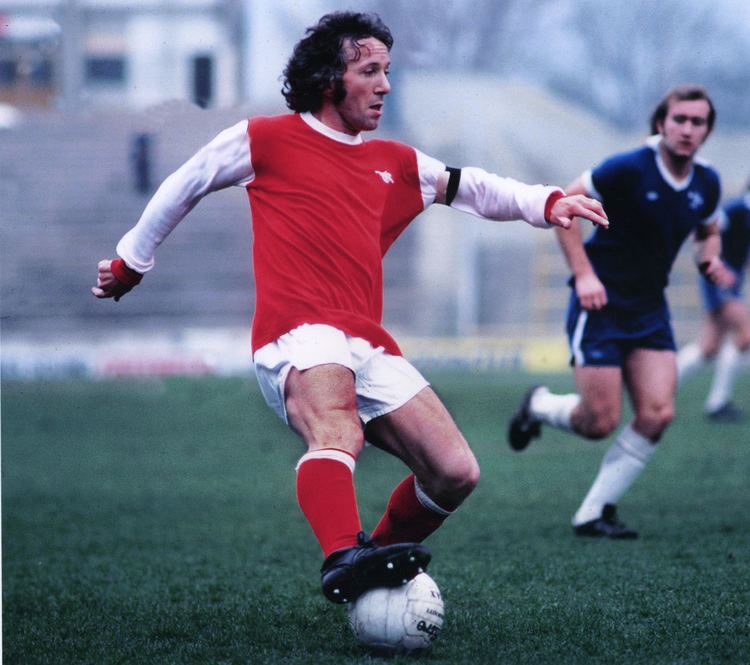Full name George Armstrong Height 1.68 m Role Football player | Name George Armstrong Years Team | |
 | ||
Date of birth (1944-08-09)9 August 1944 Date of death 1 November 2000(2000-11-01) (aged 56) Died November 1, 2000, Hemel Hempstead, United Kingdom | ||
George "Geordie" Armstrong (9 August 1944 – 1 November 2000) was an English footballer and coach, who was mostly associated with Arsenal. As a winger, Armstrong made his Arsenal debut in 1962 at the age of 17 being all in all capped 621 times, of which was an all-time club record, before he left Highbury in 1977. He spent a season each with Leicester City and Stockport County. He thereafter took up coaching, both domestically and abroad. After a year as Kuwait national team manager, Armstrong returned to Arsenal as reserve-team coach in 1990, a post which he held for several years.
Contents

Playing career

Armstrong was born in Hebburn, County Durham. After leaving school he took up an apprenticeship as an electrician and played amateur football. He had an unsuccessful trial with Grimsby Town, and signed forms for Newcastle United, before linking up with Arsenal.

Armstrong arrived at Highbury playing as an centre forward but was soon switched to the wings. He debuted soon after joining up with Arsenal while still only 17, as he started in a match against Blackpool on 24 February 1962 which was won by 1–0. Although he was at first an understudy to Johnny MacLeod and Alan Skirton, by the 1963–64 season he had become a regular in the side. As such during the 1964–65 season he missed only two matches for the club.
Over time Armstrong became one of Arsenal's most consistent players, who was noted for the quality and accuracy of his crossing and corner kicks, as well as for his tireless runs along the wing. He primarily played on the left, but was also effective as a right winger. Signed by George Swindin but maturing under Billy Wright's management, he was one of several players from the Wright era such as Jon Sammels and Peter Storey who became an integral part of successor Bertie Mee's Arsenal side.
After losing two successive League Cup finals in 1967–68 and 1968–69, Armstrong was instrumental in the Gunners winning the 1969–70 Inter-Cities Fairs Cup. As so he was voted as Arsenal's Player of the Year for 1970. Armstrong was ever-present in the Gunners 1970-71 double-winning team where they lifted the League title and FA Cup. During that 1970-71 season he set up a number of goals, as in his teeing up of Ray Kennedy's winning header against Tottenham Hotspur at White Hart Lane in the game that won Arsenal the League title.
Armstrong in staying with the club played an average of thirty matches a season. However, after falling out with Mee's successor, Terry Neill, he moved to Leicester City in September 1977 for £15,000. He played a sum of 14 League games in his single season with the Foxes, and finished his career with Stockport County before retiring in 1979.
Having spent fifteen seasons in all as an ever regular presence at Arsenal, Armstrong held the club's all-time record for appearances being 621 caps, of which included exactly 500 within the league. His record has since been overtaken only by David O'Leary and Tony Adams. He also scored 68 goals for the club altogether. Armstrong has been described as one of the most accomplished players never to have won a full cap" for England, despite being a youth international who was capped five times for the English under-23 team. This scenario has been partly attributed to England manager Alf Ramsey's policy of not using wingers.
Coaching career
After bringing his playing days to a close, Armstrong became a coach for clubs such as, Fulham, Aston Villa, Middlesbrough and Queens Park Rangers. He was also at the helm of Enderby Town and Norwegian club FK Mjølner, and managed the Kuwaiti national team between 1988 and 1989. In 1990, before the Iraqi invasion, he returned to England, where he joined Arsenal as reserve team coach, a post which he retained for several years This was so despite the many managerial upheavals that the club underwent. During his time coaching at Arsenal Armstrong was responsible for bringing many young players through the ranks, including Steve Morrow, Ray Parlour and Paul Dickov.
On 31 October 2000, Armstrong collapsed after a brain haemorrhage while at a club training session. He later died in Hemel Hempstead Hospital during the early hours of the following morning. He was survived by his wife, Marjorie, and their two children, Jill and Tom. A pitch that's at Arsenal's training ground, in London Colney has been named in his memory.
Club
Arsenal
